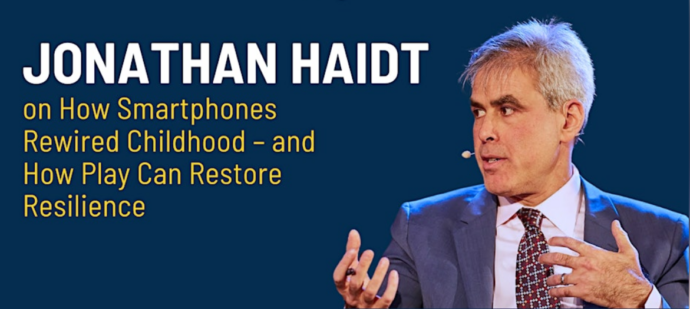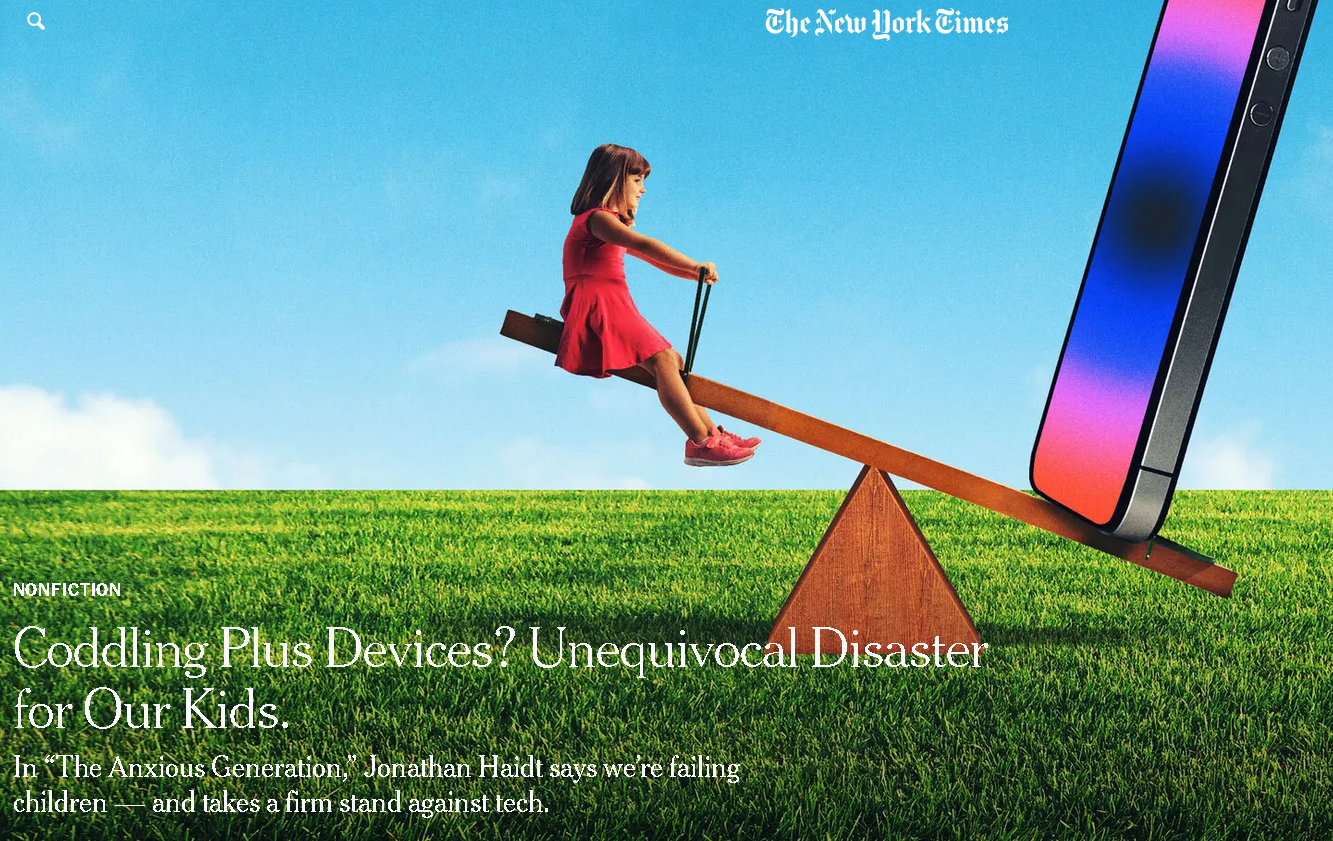April 21st, 2024
BURLINGTON, ON
“The Anxious Generation,” by Jonathan Haidt, is described as “erudite, engaging and combative in a New York Times Book Review. A must read for parents.
He writes about how we “hem and haw about the risks, failing to keep our kids safely grounded in nondigital reality. The result can no longer be ignored – anxiety, depression, suicidality – is plaguing our youth.
Haidt, a social psychologist, is a man on a mission to correct this collective failure. His first step is to convince us that youth are experiencing a “tidal wave” of suffering. In a single chapter and with a dozen carefully curated graphs, he depicts increases in mental illness and distress beginning around 2012. Young adolescent girls are hit hardest, but boys are in pain, too, as are older teens.
The timing of this is key because it coincides with the rise of what he terms phone-based childhood. From the late 2000s to the early 2010s, smartphones, bristling with social media apps and fueled by high-speed internet, became ubiquitous. Their siren call, addictive by design and perpetually distracting, quickly spirited kids to worlds beyond our control.
It wasn’t phones alone. A second phenomenon coincided with the rise of the machines: the decline of play-based childhood. This change started in the 1980s, with kidnapping fears and stranger danger driving parents toward fear-based overparenting. This decimated children’s unsupervised, self-directed playtime and restricted their freedom of movement.
With parents and children alike stuck in “Defend mode,” kids were in turn blocked from discovery mode, where they face challenges, take risks and explore — the building blocks of anti-fragility, or the ability to grow stronger through adversity. Compared to a generation ago, our children are spending more time on their phones and less on, well, sex, drugs and rock n’ roll. While fewer hospital visits and teen pregnancies are obvious wins, less risk-taking overall could stunt independence.
That’s why parents, he argues, should become more like gardeners who cultivate conditions for children to independently grow and flourish, and less like carpenters, who work obsessively to control, design and shape their offspring. We’ve overprotected our kids in the real world while underprotecting them in the virtual one, leaving them too much to their own devices, literally and figuratively.
 It’s this one-two punch of smartphones plus overprotective parenting, Haidt posits, that led to the great rewiring of childhood and the associated harms driving mental illness: social deprivation, sleep deprivation, attention fragmentation and addiction. He has a lot to say about each of these.
It’s this one-two punch of smartphones plus overprotective parenting, Haidt posits, that led to the great rewiring of childhood and the associated harms driving mental illness: social deprivation, sleep deprivation, attention fragmentation and addiction. He has a lot to say about each of these.
Here is where his ideas and interpretation of research become contentious. Few would disagree that unhealthy use of social media contributes to psychological problems, or that parenting plays a role. But mental illness is complex: a multidetermined synergy between risk and resilience. Clinical scientists don’t look for magic-bullet explanations. They seek to understand how, for whom and in what contexts psychological problems and resilience emerge.
Haidt does recognize that nuance complicates the issue. Online — but not in the book — he and colleagues report that adolescent girls from “wealthy, individualistic and secular nations” who are “less tightly bound into strong communities” are accounting for much of the crisis. So perhaps smartphones alone haven’t destroyed an entire generation. And maybe context matters. But this rarely comes through in the book.
The final sections offer advice for reducing harmful, predatory aspects of technology and helping parents, educators and communities become more gardener and less carpenter. Some tips will be familiar (ban phones from school; give kids more independence). Other advice might give readers pause (no smartphones before high school; no social media before 16). Yet, taken together, it’s a reasonable list.
Still, Haidt is a digital absolutist, skeptical that healthy relationships between youth and social media are possible. On this point, he even rebuffs the U.S. Surgeon General’s more measured position. We’re better off banning phones in schools altogether, he asserts. Because, as he quotes a middle school principal, schools without phone bans are like a “zombie apocalypse” with “all these kids in the hallways not talking to each other.”
Whether or not you agree with the zombie apocalypse diagnosis, it’s worth considering the failure of prior absolutist stances. Nancy Reagan’s Just Say No drug campaign? A public health case study in what not to do. During the AIDS crisis, fear mongering and abstinence demands didn’t prevent unsafe sex. Remember the pandemic? Telling Americans to wear masks at all times undermined public health officials’ ability to convince them to wear masks when it really mattered.
 Digital absolutism also risks blinding us to other causes — and solutions. In 1960s Britain, annual suicide rates plummeted. Many believed the drop was due to improved antidepressant medications or life just getting better. They weren’t looking in the right place. The phase-out of coal-based gas for household stoves blocked the most common method of suicide: gas poisoning. Means restriction, because it gives the despairing one less opportunity for self-harm, has since become a key strategy for suicide prevention.
Digital absolutism also risks blinding us to other causes — and solutions. In 1960s Britain, annual suicide rates plummeted. Many believed the drop was due to improved antidepressant medications or life just getting better. They weren’t looking in the right place. The phase-out of coal-based gas for household stoves blocked the most common method of suicide: gas poisoning. Means restriction, because it gives the despairing one less opportunity for self-harm, has since become a key strategy for suicide prevention.
Yes, digital absolutism might convince policymakers to change laws and increase regulation. It might be a wake-up call for some parents. But it also might backfire, plunging us into defense mode and blocking our path of discovery toward healthy and empowered digital citizenship.
THE ANXIOUS GENERATION: How the Great Rewiring of Childhood Is Causing an Epidemic of Mental Illness | By Jonathan Haidt | Penguin Press | 385 pp. | $30






















Leave a Reply